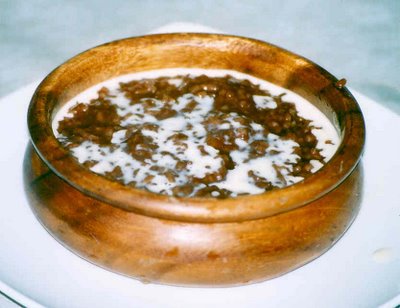
[Diwal on the shell]
The last two times I had been in Iloilo, the default dinner place had been at Breakthrough, a seafood house along the beach in the outskirts of the city, courtesy of Ilonggo friends.
This trip was no exception, courtesy of the family of a colleague who are native Ilonggos.
It would have been nice to dine there during the daytime, for the seaside view and the breeze. Friends and I once had lunch at default inasal place Tatoy's, which is directly across Guimaras island and by the same stretch of beach as Breakthrough's. It had been nice burrowing toes in the sand and watching people ferry to and from Guimaras while waiting for our orders to cook.

At Breakthrough, the waves breaking through the beach was a constant presence, though only in the auditory sense. I wondered why no lamps had been hung outside the restaurant, to illuminate the sea. As it was, you'd forget you were so close to the water dining there in the evenings, as outside the bamboo rails of the open air restaurant everything was jet black. Not even the seafoam was visible.
Nonetheless, it has always been a satisfying experience eating at Breakthrough. Fresh seafood, expert cooking, fast service, convivial atmosphere, and an extremely relaxed ambience make for a fine meal. And Breakthrough showcases the best that the seas around Western Visayas can offer.

There were no diwal at the public market when I went there hours before dinner. It reportedly sells for Php350 per kilo, which is a hefty price for seashells. But baskets of them, live, were lying at the bottom of Breakthrough's water "well." Inclusive of cooking and serving charges, the price was a lot more steeper at Php750 per kilo. We had them simply grilled, without any sauce of any kind (they're usually served slathered with garlic and butter) to fully appreciate their briny sweetness.
I've had diwal before, during my first trip to Iloilo in the early 1990s. They were served at the home of a friend, and at the time diwal was as common as ordinary clams. They disappeared afterwards, and it is only now that they are slowly making a comeback.




This trip was no exception, courtesy of the family of a colleague who are native Ilonggos.
It would have been nice to dine there during the daytime, for the seaside view and the breeze. Friends and I once had lunch at default inasal place Tatoy's, which is directly across Guimaras island and by the same stretch of beach as Breakthrough's. It had been nice burrowing toes in the sand and watching people ferry to and from Guimaras while waiting for our orders to cook.

[Roasted diwal, or angelwing clam, Pholas orientales]
At Breakthrough, the waves breaking through the beach was a constant presence, though only in the auditory sense. I wondered why no lamps had been hung outside the restaurant, to illuminate the sea. As it was, you'd forget you were so close to the water dining there in the evenings, as outside the bamboo rails of the open air restaurant everything was jet black. Not even the seafoam was visible.
Nonetheless, it has always been a satisfying experience eating at Breakthrough. Fresh seafood, expert cooking, fast service, convivial atmosphere, and an extremely relaxed ambience make for a fine meal. And Breakthrough showcases the best that the seas around Western Visayas can offer.

[Live diwal just out of the water]
There were no diwal at the public market when I went there hours before dinner. It reportedly sells for Php350 per kilo, which is a hefty price for seashells. But baskets of them, live, were lying at the bottom of Breakthrough's water "well." Inclusive of cooking and serving charges, the price was a lot more steeper at Php750 per kilo. We had them simply grilled, without any sauce of any kind (they're usually served slathered with garlic and butter) to fully appreciate their briny sweetness.
I've had diwal before, during my first trip to Iloilo in the early 1990s. They were served at the home of a friend, and at the time diwal was as common as ordinary clams. They disappeared afterwards, and it is only now that they are slowly making a comeback.

Plump and juicy, very sweet, very fresh scallops, with fried garlic and butter. To die for.

Grilled lokus (squid), stuffed with sliced onions and tomatoes

Crabmeat, sauteed with butter, onions, potatoes and bell peppers, served on a sizzling plate

Butterflied and grilled managat, a local fish (red snapper, Lutjanus campechanus). The fishheads went into a refreshing soup soured with batwan.
Breakthrough Seafoods & Restaurant
Sto. Nino Norte, Arevalo (Villa), Iloilo City
Tel. No. (633) 3373027
Iloilo in 24 Hours
Lunch: Nora's
Baye-baye
Public Market
Roberto's Siopao
Related Post
Panaderia de Molo










































